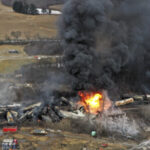As traffic has increased in western North Dakota’s booming oil patch, so have fatal vehicle crashes.
Mark Berwick, a research associate at the Fargo-based, Upper Great Plains Transportation Institute tells The Bismarck Tribune that 42 percent of the 2011 fatalities on North Dakota roads through Dec. 20 were in the northwestern part of the state.
The state’s other three regions that include areas of much higher populations such as the cities of Fargo and Bismarck each had 20 percent or less of the state’s fatalities.
Through last Thursday, 145 people had died on North Dakota roads, making 2011 the most dangerous year on state roads in recent history.
Terry Weaver, traffic safety program coordinator for the North Dakota Safety Council, said 60 of the 145 fatalities involved alcohol use.
In 75 of the cases, people who died were not wearing seat belts, compared to 31 who were.
The 145 total fatalities also include 14 people killed in motorcycle crashes, 10 pedestrians killed and one person killed in a bicycle crash.
Weaver said the statistics show the risk in rollover crashes more than any other kind: 85.7 percent of people killed in rollover crashes were not wearing seat belts and were thrown from vehicles.
Safety officials hoped 2009’s traffic fatality count of 140 was an anomaly after deaths on North Dakota roads shrunk to 105 in 2010. But 2011 has them worrying that 2010 may have been the odd year out.
“I think that if we’re looking at what is the anomaly, it might have been 2010,” Berwick said.
Williams, Ward and McKenzie counties have had substantial increases in fatalities compared to the previous year. Berwick said Williams had 10 traffic deaths through Dec. 20, compared to three in all of 2010; Ward County had 13, compared to three in 2010; and McKenzie County had 15, compared to eight in 2010.
Berwick said many factors in western North Dakota may be contributing to the increase in fatalities on the roads. The total amount of traffic has increased substantially, as has the truck traffic. There are more people in the area who are not familiar with the roads and more people who aren’t accustomed to driving through North Dakota’s winter conditions.
North Dakota Department of Transportation figures show that about 6,000 vehicles traveled on a stretch of U.S. Highway 85 west of Watford City to the junction of U.S. Highway 2 near Williston in 2011, compared to 2,300 vehicles on the same stretch in 2006.
The vehicle count on U.S. Highway 2 north of Williston to the junction of U.S. Highway 85 went from approximately 5,000 per day in 2006 to 12,000 in 2011.
Was this article valuable?
Here are more articles you may enjoy.

 Norfolk Southern to Pay $600 Million to Settle Ohio Spill Case
Norfolk Southern to Pay $600 Million to Settle Ohio Spill Case  Why Near-Miss Cyberattack Put US Officials and Tech Industry on Edge
Why Near-Miss Cyberattack Put US Officials and Tech Industry on Edge  Oregon Schools Sued for $9M After Young Girl Allegedly Raped
Oregon Schools Sued for $9M After Young Girl Allegedly Raped  Credit Suisse Unit Did ‘Incompetent Best’ for Billionaire Client, Lawyer Says
Credit Suisse Unit Did ‘Incompetent Best’ for Billionaire Client, Lawyer Says 